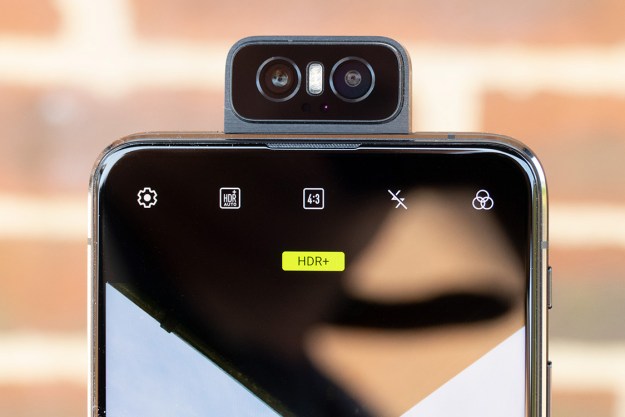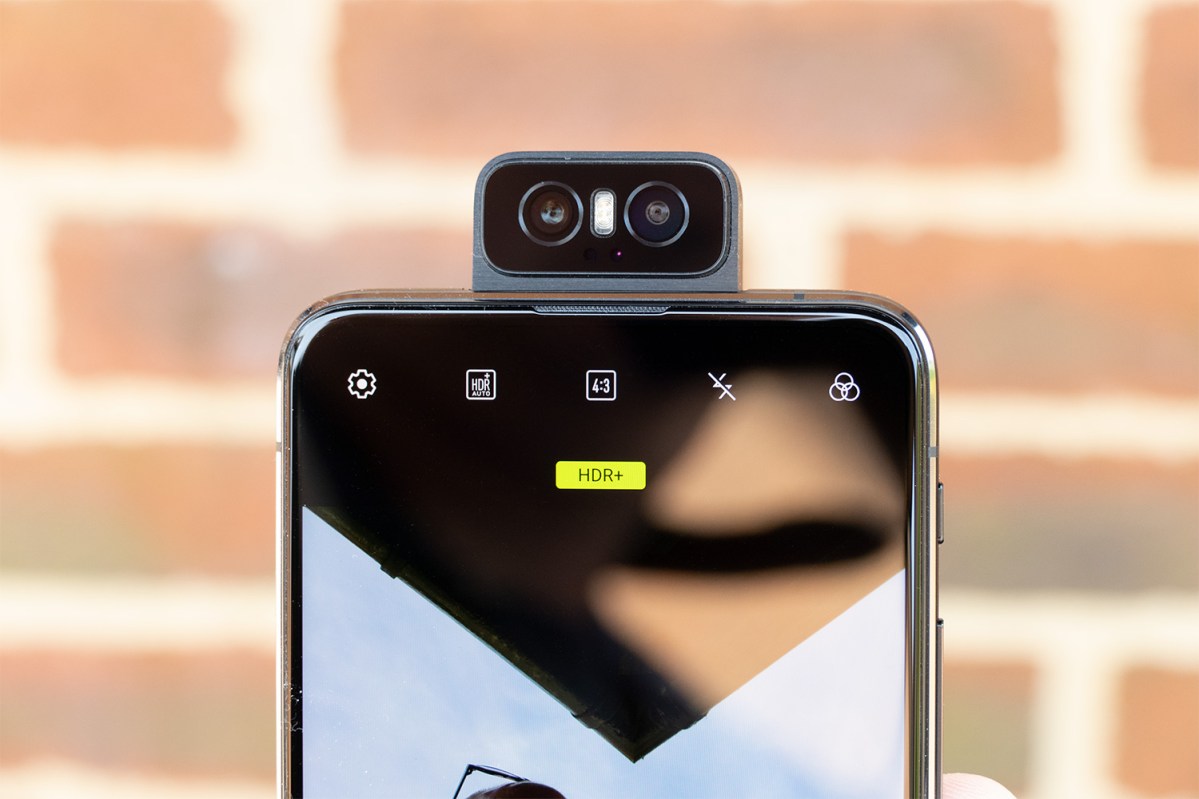
“The ZenFone 6 is Asus trying something new, and it has created an exciting flagship phone like no other.”
- Excellent, almost Pixel-like software
- Versatile camera that takes great photos
- Flip camera is brilliant for selfies
- Long battery life
- Competitive price
- No water resistance
- No wireless charging
- Dated design compared to rivals
For the ZenFone 6, Asus didn’t want to make a phone that’s the same as all the others. By approaching the core technology in a new way, the ZenFone 6 is not only one of the most interesting Asus phones in a while, but also one of the most versatile.
I’ve been using the ZenFone 6 for several weeks, and also visited Asus in Taipei, Taiwan ahead of launch to see how the ZenFone 6 was developed. Yes, the flip camera is the headline-grabbing feature, but the rest of the phone is just as interesting and unusual. It has been a very welcome, and very capable companion that makes me excited about Asus’ smartphone future.
Concept and design
The ZenFone 6 was conceived around four principles: A big-screen viewing experience, long battery life, fast and smooth performance, and photographic creativity. Lofty goals, but hardly unique. But Asus has delivered on them in some unusual ways.
The phone’s 3D, curved Gorilla Glass 3 rear blends into the metal chassis, while the Gorilla Glass 6 over the screen stands proud of the body. This technique masks the size of the phone both visually and when you hold it. If, like me, you admire the uniqueness of the Asus ROG Phone, the ZenFone 6 also has its own identity; but it’s more usable on a daily basis than the gaming phone. Does the large 5,000mAh battery make the phone too big and thick? At 9.1mm thickness — yes — but at 190 grams, it’s comparably lightweight over its rivals.
The notch-less, 6.4-inch LCD screen has a Full HD+ resolution, and although Asus calls it NanoEdge, the bezels are similar in thickness to an Apple iPhone XR or a Galaxy S10e. It also has a slightly larger “chin” or bottom bezel. It’s of good quality, but I miss an always-on AMOLED screen. The LCD also isn’t very bright when viewed outside in sunlight, and the auto brightness is slow to react, making it not good enough to compensate for fast changes.
A big-screen viewing experience, long battery life, fast and smooth performance, and photographic creativity.
Initially, a rattle caused by the camera module as the phone vibrated annoyed me. I know it’s the camera module, because when you hold it down, the phone vibrates normally. The camera module doesn’t flap about, but it doesn’t sit against the body quite tightly enough when flush in its compartment. Over time, I’ve noticed it less, but it definitely makes the phone louder in vibrate mode.
The movement when the module does flip around is highly mechanical — in that you can hear and even feel the gears working. When activating it in the camera app, it’s a smooth, nicely-dampened motion. If you slide the camera view button up and down, you can control the camera’s angle yourself, and even the speed of the movement. It feels well engineered.
I really like using the ZenFone 6, but aside from the flip camera, it doesn’t look or feel like a “modern” phone, in that it’s quite thick and has a rear-facing fingerprint sensor. This isn’t a bad thing, but compared to phones like the OnePlus 7 Pro, the ZenFone 6’s design is a step behind.
Flip-around camera
The motorized flip-around camera system is the feature everyone will talk about. To facilitate the notch-free screen, Asus has made its own interpretation of the pop-up motorized camera. From the back of the phone, the dual-lens camera looks like any other, but to take selfies, it flips over the top of the phone. Almost everything you can do with the rear camera, you can do for selfies too.
A Sony IMX586 48-megapixel camera sensor is the star of the ZenFone 6’s lens array, and it’s joined by a 13-megapixel ultra-wide lens, all wrapped up inside a wonderfully complex module made of highly durable, super-lightweight liquid metal. How complex? There are 13 gears inside delivering the torque needed to flip the camera around. In a regular pop-up camera, there are usually only five gears.
Liquid metal was chosen for durability as it’s four times more resilient than stainless steel, and the mechanical movement has been tested to 150,000 cycles. It’s really clever, too. For example, it works with the proximity sensor so it won’t accidentally open or close when it’s against the side of your face — helpful if you’ve got long hair and don’t want it caught in the mechanism — and the gyro automatically flips the camera closed when it senses the phone is being dropped, just like the OnePlus 7 Pro’s pop-up camera.

What’s it like? Using it is so much fun. The rotation moves through 180 degrees, and you can stop it at any point by using an on-screen slider or even the volume keys. I love the automatic panorama mode, where the camera itself moves to capture the scene, rather than you following directions on the screen. It even tracks movement, so you can follow a subject on the move without always being concerned about watching the viewfinder. Finally, Asus has added its own pop-up camera control overlay so you can use the feature in apps like Instagram and Twitter.
All these features will be for nothing if the quality isn’t there. After several software updates, the camera has improved considerably from the early version I tried. The HDR setting is effective, taking great shots in challenging lighting, while Night mode takes bright, clean, blur-free low-light images. It’s versatile with a 2x zoom and the wide-angle mode, plus edge detection in portrait mode is excellent.
Saturation levels are not too extreme, although some night shots are a little too smooth sometimes, and color accuracy was sometimes off in previous versions of the software — with yellow and green levels especially. Selfies outperform most other phones, due to the quality of the lenses and software. They’re really fantastic with plenty of detail, and a strong portrait mode. A beauty mode can be controlled in portrait but not in normal mode, and although some have noticed it adds some unwanted effects this way, it has not occurred for me.
The camera takes attractive, shareable photos, and has plenty of versatility, whether it’s facing toward the back or the front.
There are some downsides to the camera. It doesn’t include optical image stabilization, only electronic stabilization, because the additional weight would have dramatically affected the size and weight of the motorized module. Face unlock is onboard, but it’s not automatic — you have to slide up the screen to make it work, which is slower and less convenient than other systems.
The ZenFone 6’s camera takes attractive, shareable photos, and has plenty of versatility, whether it’s facing toward the back or the front.
Software and performance
ZenUI has been consigned to history, and in its place comes a clean, almost Pixel-like Android experience. Deep inside are a lot of speed improvements, from clearing apps to memory management, and a faster initial launch time. The work has paid off — it’s quick, fluid, and there are no irritating slowdowns when switching between multiple apps.
The simple Android experience means you have a slide-up app tray, a slide-down notification screen, and the Google Feed to the left of the home screen. App icons are consistently designed, the design is pleasantly coherent, and there are only a few pre-installed Asus apps. It’s still customizable, and Asus has added some cool features — for example I switched to the new Asus-made Dark Mode and haven’t gone back.

ZenUI on the ZenFone 6 is a massive step forward in gaining mainstream appeal for the phone, and it’s excellent. It’s incredibly close to using Android on a Pixel, and is smooth, fast, and for the most part reliable too. It has crashed a few times — mostly the Gmail app, oddly — but that’s all. ZenUI is a genuine reason to buy the ZenFone 6 over phones with more complex, highly–customized user interfaces. Asus has also been sending out updates to my early review model too, with the third one arriving as this review is being written. It’s good to see commitment like this — you won’t find timely updates on comparably-priced phones like the Moto Z4.
No compromises have been made on the specifications. The Snapdragon 855 processor is inside with 8GB of RAM and up to 256GB storage space. Asus worked hard to redesign the PCB, creating a two-piece board, so it can fit in a triple-slot SIM tray with room for two SIM cards and a MicroSD card as well. This is very welcome, and more preferable than having to choose between storage and a second SIM.
Here are the benchmark results (with those completed using Asus’ AI Boost feature, which promised to improve benchmark test results, in parenthesis):
- AnTuTu 3DBench: 361,821 (383,158)
- Geekbench 4 CPU: 3,520 single-core; 11,141 multi-core
- 3DMark Sling Shot Extreme: 4,936 (Vulkan)
I have not come across a situation where the ZenFone 6 lacks power, or is anything other than pleasurable to use; the benchmark scores prove its prowess, as the base AnTuTu score is the third highest score we’ve seen to date, coming short of the OnePlus 7 Pro and the 2019 iPad Air.
Battery and security
Asus went to some lengths to explain to Digital Trends why it has made certain decisions on the ZenFone 6. It has a rear fingerprint sensor and not an in-display sensor because it would have made fitting in the large battery and a 3.5mm headphone port impossible. The rear sensor is a tried-and-tested method of securing a smartphone and it’s fast and reliable here, but it doesn’t keep up with the latest design trends. The ZenFone 6 looks dated because of it.
The 5,000mAh battery is excellent. Although it only returned 12 hours 37 minutes in our continuous YouTube video test — meaning it’s bested by the Huawei P30 Pro, which has a smaller capacity battery — on a daily basis it’s incredibly strong. Even on the heaviest usage days, it never fell below 20%, and with light use it sometimes finished at above 50%.
Two days careful use is easily possible, and I’ve even had a weekend away where I forgot a charger, switched to airplane mode overnight, and still had power for regular use with Google Maps guidance on the second day.
For charging, you have to plug it in as there’s no wireless charging. Asus says it impacts the battery’s lifespan over time, which is also the reason it doesn’t have charging faster than 18W. This is something we haven’t found to be entirely true in our research. Regardless, the higher capacity battery is how Asus chose to deal with these problems, as the extended use time cuts down the need to recharge so often, or so quickly.
It works. Battery anxiety is not a problem with the ZenFone 6.
Price, warranty, and availability
The ZenFone 6 is available in Europe and the U.S., at 500 euros and $500 respectively. You’ll be able to pick it up in the U.S. from Asus, Amazon, B&H, and Mobile Advance. There’s a year’s warranty, and like the ROG Phone, it covers manufacturing defects, but not misuse or water damage.
Our Take
The ZenFone 6 embodies everything that’s great about smartphones in 2019. It doesn’t follow trends set by Apple and Samsung, it doesn’t just adopt the features other manufacturers have chosen, and it doesn’t repeat mistakes that have hurt ZenFone models in the past. Asus has taken a step back, relaxed, and thought about what it needs to do to compete this year. The ZenFone 6 is the result, and it’s superb.
Is there a better alternative?
At $500, the Asus ZenFone 6 is a bargain; but there are some other great cheap phones to consider before buying it. In the U.S. the $550 OnePlus 6T is its best and closest competitor when it comes to price, but the $400 Google Pixel 3a has a very strong camera and software experience for a slightly lower price. Spend a little more to get the $750 OnePlus 7 Pro for its beautiful screen and ultra-modern looks.
In the U.K., if the ZenFone 6 hits a 500 British pound price tag, the 500 pound OnePlus 7 is its direct competitor, along with the excellent Xiaomi Mi 9 at around the same price. The Honor 20 Pro should arrive at the end of July, or a little before, and will also be similarly priced. These all offer more features and more power than the 400 pound Google Pixel 3a, which doesn’t represent as good value in the U.K..
How long will it last?
This is not a rugged phone, so you’ll have to be careful if you want it to last. There is no IP rating for water resistance, but Asus said it’s protected against rain and general damp conditions. The body is made from glass, and I did manage to crack the back of my review phone after a very minor fall. There is a polycarbonate case included in the box, and I recommend using it.
Otherwise, the phone will easily last more than the duration of a two-year contract, due to it having the latest processor, currently good software support, and an innovative and fun camera.
Should you buy it?
Yes. The Asus ZenFone 6 has the performance, the battery life, and the software experience we want from a great smartphone in 2019, at a price that’s very competitive. Plus, the flip-over camera is not a gimmick and does come with some interesting features. The ZenFone 6 easily holds its own in 2019, even among this year’s serious smartphone competition.
Editors' Recommendations
- The best folding phones in 2024: the 6 best you can buy
- The best Google Pixel 6a cases and covers
- Does the Pixel 6a have an SD card slot? How the phone handles expandable storage
- Asus will show the small, powerful phone you’ve been waiting for on July 28
- The Zenfone 9 looks like the small 2022 flagship you’ve been waiting for
















